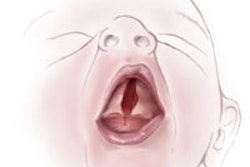An international team of researchers has identified a gene that plays a major role in cleft lip and cleft palate, according to a study published in Human Molecular Genetics (December 15, 2009, Vol. 18:24, pp. 4879-4896).
Lina Morena, D.D.S., Ph.D., an assistant professor in the department of orthodontics at the University of Iowa (UI) College of Dentistry, was the study's co-leader.
Dr. Morena and her UI colleagues had previously identified a segment of the human genome, called chromosome 9, as the location of an important genetic cause of cleft lip and cleft palate. Through further research and analysis of DNA from affected families, they have now identified a single gene on chromosome 9 as a root cause of these common birth defects.
The gene, known as FOXE1, appears to contribute to cleft lip with or without cleft palate, and isolated cleft palate. Previously, these two forms of clefting were thought to arise from different genetic abnormalities.
Although they do not yet know how FOXE1 abnormalities cause clefting, the gene might be part of a new pathway involved in lip and palate formation. In addition, FOXE1 is known to have a role in the formation of the thyroid gland, which might mean a connection exists between thyroid function and cleft lip and cleft palate. Understanding what the mutation does to the gene and which biological pathways are affected could potentially lead to new therapeutic approaches, according to the study authors.
The American Association of Orthodontists Foundation, the March of Dimes, the National Institutes of Health, and the Cleft Palate Foundation were among the organizations that provided funding for this project.
Copyright © 2010 DrBicuspid.com



















